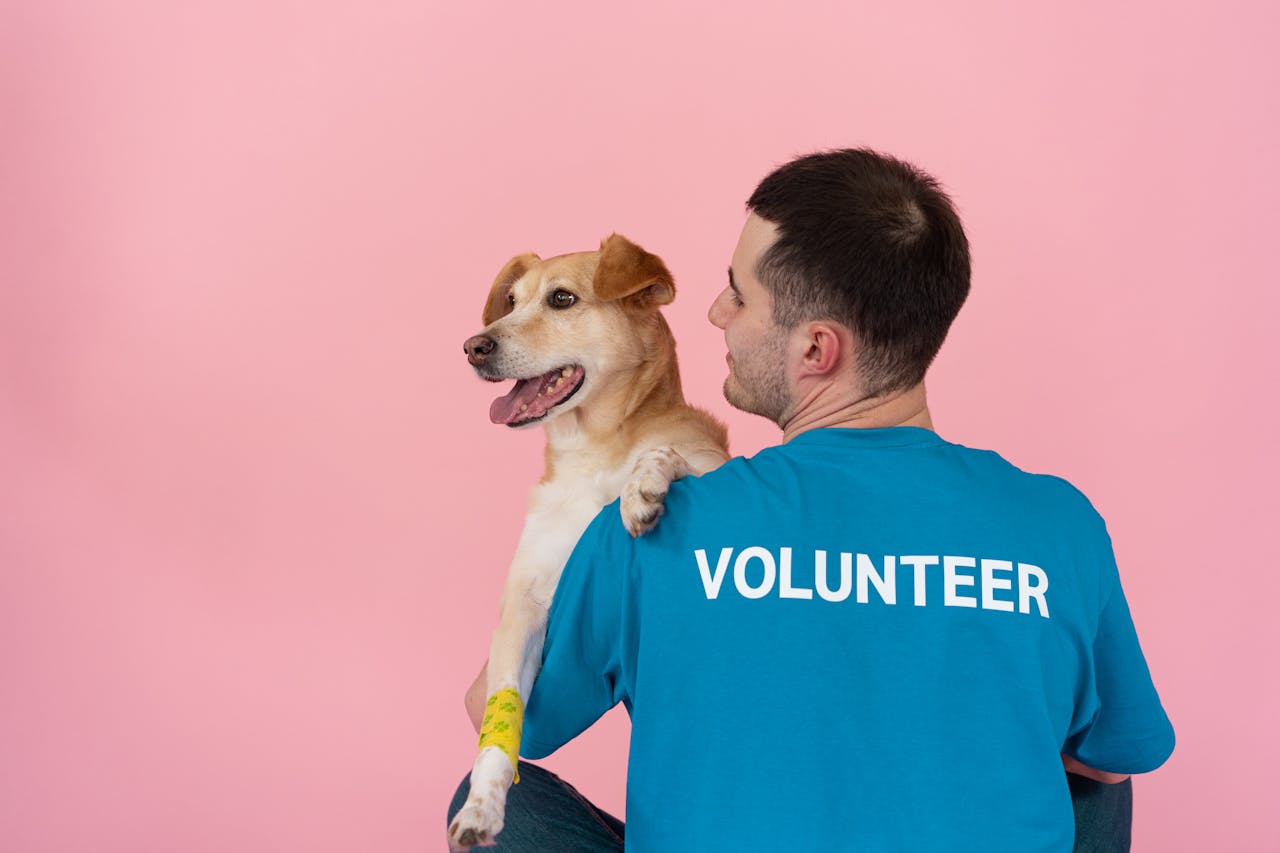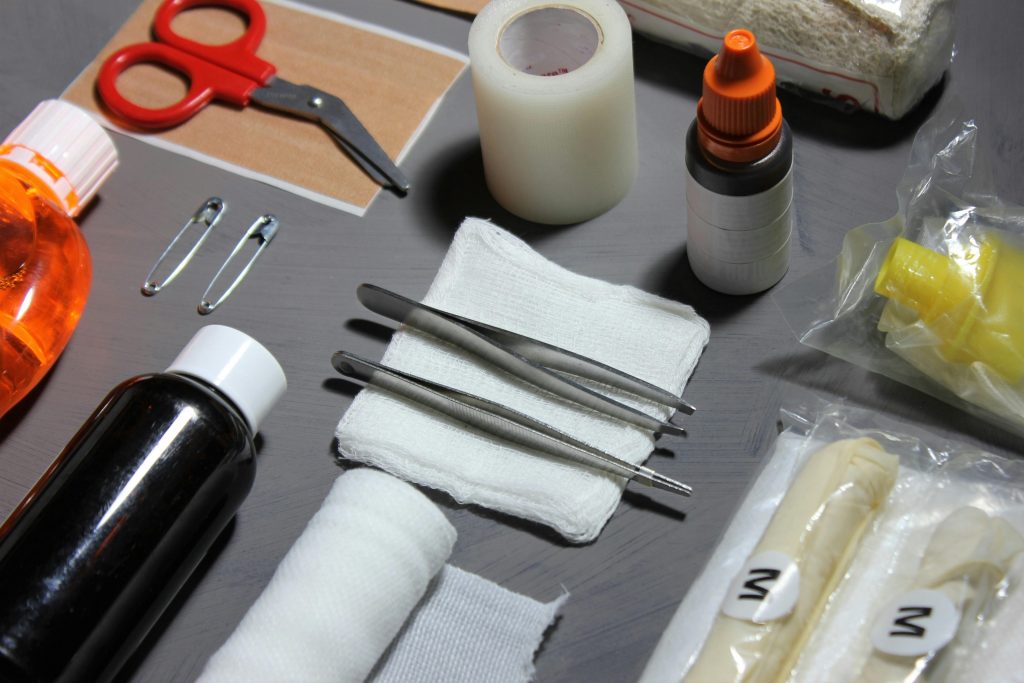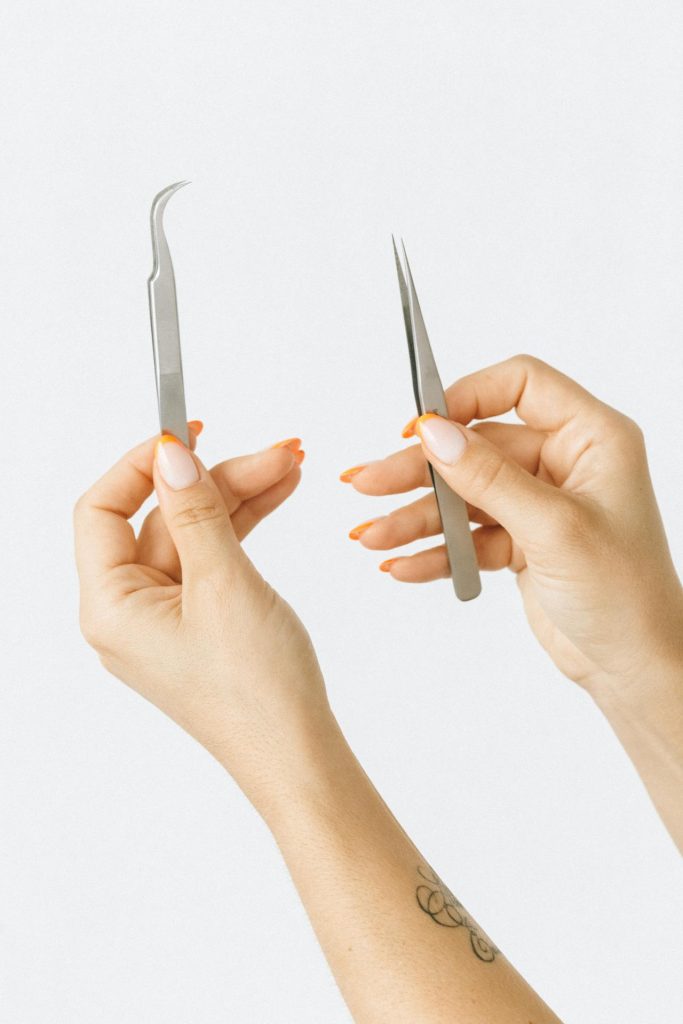
Imagine hiking with a dog when they suddenly step on broken glass or have an allergic reaction miles from a veterinary clinic. These scenarios are more common than dog owners realize. Being unprepared during a pet emergency can turn a manageable situation into a crisis.
Having a dog first aid kit allows you to address common injuries like cuts, scrapes, or insect stings until professional veterinary care is accessible. With the right supplies, one can control bleeding, clean wounds, and monitor vital signs during those critical first moments.
This guide covers essential components of a canine first aid kit, explains each item’s purpose, and shows how a small investment in emergency preparedness can save a dog’s life, whether at home, camping, or enjoying a day at the park.
When Should You Use a Thermometer, Gloves, or a Leash in Emergency Care?

When a dog suddenly seems lethargic or unwell, knowing when and how to use basic emergency supplies can make a critical difference. These three simple tools—thermometers, gloves, and leashes—are fundamental components of effective canine emergency care.
Using a thermometer to check vital signs
A digital thermometer provides one of the most reliable indicators of a dog’s health status. Unlike humans, dogs naturally run warmer—a normal canine temperature ranges between 100°F and 102.5°F. Taking a dog’s temperature when they appear sick helps determine whether veterinary intervention is necessary.
Temperature readings outside the normal range can indicate serious health issues:
- Above 104°F: Requires immediate veterinary attention as it could indicate infection, inflammation, or heat stroke
- Above 106°F: Constitutes a life-threatening emergency requiring immediate cooling measures while en route to an emergency clinic
- Below 99°F: Could signal shock, hypothermia, or severe illness—contact a vet right away
When using a thermometer, apply a water-based lubricant to the tip for a dog’s comfort. Having assistance to restrain the dog during temperature-taking makes the process safer and less stressful for everyone involved.
| Normal Temperature Range | 100°F – 102.5°F | 37.8°C – 39.2°C |
| Immediate Veterinary Attention Required | Above 104°F | Above 40°C |
| Life-Threatening Emergency | Above 106°F | Above 41.1°C |
| Hypothermia Concern | Below 99°F | Below 37.2°C |
Why gloves are essential safety equipment
Nitrile or latex gloves serve as crucial personal protective equipment during any first aid situation. They create a barrier that protects both the handler and the dog from potential contamination and infection.
Wearing gloves becomes particularly important when:
- Cleaning wounds or handling bloody injuries
- Applying antiseptic wipes to cuts or scrapes
- Removing ticks with tweezers
- Handling bodily fluids or potentially toxic substances
Beyond infection control, gloves also provide better grip when handling bandages and emergency supplies. Keeping several pairs in a pet first aid kit ensures preparedness.
The role of a leash in emergency situations
A slip lead or standard leash might seem basic, but it’s one of the most versatile tools in canine emergency care. Even the gentlest dog may act unpredictably when injured or frightened.
A leash helps:
- Maintain control if a dog panics or tries to flee from pain
- Safely transport the dog to veterinary care
- Create an improvised muzzle if necessary (though a proper muzzle is preferable)
- Fashion a temporary restraint while administering emergency care
Keeping a slip lead in an emergency kit can be helpful since it can be quickly looped around a dog’s neck without needing to fasten a collar—perfect for situations where every second counts.
In emergencies, a dog’s natural fight-or-flight response may trigger unusual behavior. It’s important to handle injured dogs gently but securely, speaking in calm tones while using appropriate restraint methods.
With these three simple tools—a thermometer to check vital signs, gloves for protection, and a leash for control—one is better equipped to provide effective emergency care for a dog until professional help becomes available.
What Essentials Should Every Dog First Aid Kit Include?

Assembling a comprehensive dog first aid kit isn’t just responsible pet ownership—it’s peace of mind when adventures go sideways. Whether a dog tangles with a porcupine on a hiking trail or suffers a paw pad injury at the dog park, having the right supplies means not being caught unprepared.
Wound Care Supplies
The most common emergencies involve cuts, scrapes, or punctures. A kit should contain non-stick gauze pads to cover wounds without painful removal, roll bandages that conform to awkward areas like legs or paws, and medical adhesive tape to secure everything in place. Never use human bandages with adhesive that can tear fur and cause additional pain.
For cleaning wounds, include saline solution to flush debris from cuts without causing irritation. Many experienced dog owners keep antiseptic wipes specifically formulated for pets, as human versions may contain ingredients harmful to dogs if licked or ingested.
Tools and Equipment
Quality tools make all the difference in an emergency. Blunt-tipped scissors allow trimming of fur around wounds or cutting bandages without risking additional injury. Tweezers are invaluable for removing splinters, ticks, or small foreign objects from paws. A digital thermometer provides crucial information about a dog’s condition—normal canine temperature ranges from 99.5-102.5°F, significantly different from humans.
Non-latex disposable gloves protect both the handler and dog during first aid procedures. In one example, gloves prevented potential infection while keeping a paw cut clean during treatment on a camping trip.
| Item | Use |
|---|---|
| Digital Thermometer | Used to check vital signs by measuring the dog’s temperature to assess health status. |
| Nitrile or Latex Gloves | Used to protect against contamination and infection when handling injuries. |
| Slip Lead | Helps to maintain control of the dog, can be used as an improvised muzzle or for emergency transportation. |
| Non-Stick Gauze Pads | Used to cover wounds without painful removal. |
| Roll Bandages | Used to secure gauze pads and provide additional support to the injured area. |
| Saline Solution | Used for flushing debris from cuts or wounds to prevent irritation. |
| Blunt-tipped Scissors | Used for trimming fur around wounds and cutting bandages without causing further injury. |
| Antiseptic Wipes | Used to clean wounds and reduce infection risk. |
| Tweezers | Used for removing splinters, ticks, or foreign objects from the dog’s skin or paws. |
| Benadryl (Diphenhydramine) | Used for managing allergic reactions from insect stings or environmental allergens. |
| Styptic Powder | Used to stop minor bleeding from cuts or injuries. |
Medications and Treatments
Include only dog-safe medications in a kit. Benadryl (diphenhydramine) can help with allergic reactions from insect stings or environmental irritants—typically dosed at 1mg per pound of body weight, but always verify with a veterinarian first. Styptic powder stops bleeding from minor cuts or torn nails, a common injury during outdoor activities.
Hydrogen peroxide might be included for inducing vomiting in poisoning emergencies, but this should only be used after consulting a veterinarian or poison control. The general guideline is 1 teaspoon per 5 pounds of dog weight, administered only when specifically instructed by a professional.
Control and Comfort Items
Even the gentlest dog may bite when in pain. A soft muzzle appropriate for the dog’s size is a safety essential, not a punishment. Practice using it occasionally so the dog doesn’t associate it only with stressful situations.
A slip leash provides quick control in emergency transport situations when a regular collar and leash aren’t available. For comfort and shock prevention, include a towel or emergency blanket that can provide warmth or serve as an improvised stretcher for a small dog.
Documentation and Information
Store a veterinarian’s contact information, the nearest emergency vet clinic number, and poison control hotline (ASPCA Animal Poison Control: 888-426-4435) in a waterproof container or laminated card. Include copies of the dog’s vaccination records, medication list, and any medical conditions. During a crisis, crucial details that emergency providers need may be hard to remember.
Store the kit in a bright, waterproof container that’s easily identifiable and regularly check expiration dates on medications, replacing as needed. The best first aid kit is complete and current when emergencies strike.
How to Use Bandages, Antiseptic Wipes, and Tweezers in Canine Emergencies

When a dog suffers an injury during a weekend hike or backyard play, knowing how to properly use first aid supplies can make a critical difference before reaching veterinary care. This article explores the proper techniques for using three essential emergency tools that every pet parent should master.
Using Bandages for Wound Care
Bandages serve as the first line of defense against infection and excessive bleeding. In summer 2023, emergency veterinarians reported a 30% increase in outdoor paw injuries, highlighting why proper bandaging technique matters. Clean the wound area thoroughly before applying any wrapping.
To bandage a dog’s wound properly:
- Place a clean, non-stick gauze pad directly over the injury
- Secure with roll gauze, wrapping in a spiral pattern from below the wound upward
- Apply gentle pressure—firm enough to stay in place but loose enough to slip two fingers under the edge
- Secure with medical tape, avoiding hair when possible
- Monitor for swelling, temperature changes, or discoloration in the area below the bandage
Bandaging too tightly can restrict circulation and cause more harm than good. Check the bandage every 2-3 hours and loosen if necessary. If the dog’s toes feel cold or appear swollen, the bandage needs immediate adjustment.
Proper Use of Antiseptic Wipes
Antiseptic wipes provide portable wound cleaning when soap and water are unavailable. Veterinary research shows that properly cleaned wounds have a 60% lower infection rate than untreated injuries, making this step crucial.
When using antiseptic wipes:
- Gently remove visible debris from the wound
- Wipe from the center outward in a single motion
- Use a new wipe for each stroke to prevent recontamination
- Never use alcohol wipes directly on an open wound
- Allow the area to dry completely before bandaging
For an injured paw pad, holding the wipe in place for 30 seconds helps disinfect deeper cuts effectively. While chlorhexidine or iodine-based wipes are ideal for emergency wound care, never use them near a dog’s eyes or inside ears without veterinary guidance.
Expert Tick and Foreign Object Removal with Tweezers
Tweezers become indispensable when a dog picks up unwanted passengers like ticks or steps on thorns during trail adventures. The tick removal technique requires particular attention since improper removal can leave mouthparts embedded in the dog’s skin.
For proper tick removal:
- Use pointed tweezers with a fine tip
- Grasp the tick as close to the dog’s skin as possible
- Pull upward with steady, even pressure
- Avoid twisting or jerking movements
- Disinfect the area after removal
When removing splinters or thorns, patience and proper lighting are key. Position the dog comfortably, use a second person as a helper if possible, and work methodically. Always sterilize tweezers before and after use with an antiseptic wipe or alcohol to prevent introducing bacteria into the wound.
Many dog owners underestimate how challenging these skills can be during an actual emergency. Practicing these techniques during calm moments can ensure that muscle memory takes over when stress levels are high. The investment of time now could save critical minutes when a dog needs help most.
What are Smart Ways to Store Your Dog Emergency Supplies for Travel and Adventures?

When venturing outdoors with a dog, proper storage of emergency supplies can make the difference between a minor hiccup and a trip-ending disaster. Strategic organization ensures quick access when a dog steps on a sharp object or encounters an unexpected hazard miles from civilization.
Investing in a dedicated waterproof container is essential for protecting critical supplies. The Adventure Medical Kits Trail Dog First Aid Kit offers excellent water resistance with its DryFlex zipper bag that shields bandages and antiseptic wipes from moisture damage. Discovering medical supplies have become unusable during a rainstorm quickly derails outdoor fun.
Organizing by Emergency Type
Organize supplies by emergency type rather than tossing everything into one compartment. Keep wound care items like bandages, gauze, and antiseptic wipes in one clearly marked section. Store diagnostic tools such as a thermometer and tweezers in another. This system allows for quick access during stressful situations when a dog needs immediate attention.
Accessibility matters during outdoor activities. The weight and bulk of an emergency kit directly impact its portability. For backpacking trips where every ounce counts, the My Medic Pet Medic Med Pack weighs just over 6 ounces while containing essential supplies. For car camping or road trips, a more comprehensive kit with extra supplies is manageable.
Documentation and Medication Management
Store critical documentation in waterproof, ziplock bags within the main kit. Include a veterinarian’s contact information, vaccination records, and medication instructions. For prescription medications, use small waterproof containers with clear labels detailing dosage information and expiration dates.
Portable water filtration systems make excellent additions to dog emergency kits, ensuring proper hydration even when clean water sources aren’t readily available. Many experienced hikers place collapsible water bowls near the top of their packs for quick access during rest breaks.
Custom Solutions for Different Adventures
Different activities require tailored approaches to emergency supply storage. For day hikes, a lightweight pouch attached to a belt or backpack provides quick access to essentials. For multi-day camping trips, a more comprehensive kit stored in a vehicle serves as a resupply point.
Consider a dog’s specific needs when customizing an emergency kit. Active breeds prone to pad injuries might benefit from extra leash options and protective booties. Dogs with allergies might need additional antihistamine medications packed separately but clearly labeled.
Regular maintenance ensures supplies remain effective. Check expiration dates quarterly, replace used items promptly, and adjust contents based on seasonal activities. Styptic powder should be stored in a tightly sealed container to prevent moisture absorption, which reduces effectiveness.
For outdoor adventures far from cellular service, including a slip leash in an easily accessible exterior pocket provides immediate control if a dog becomes injured or disoriented. This simple tool can prevent a minor incident from escalating into a major emergency.
Be Ready for Any Situation with a Well-Stocked Dog First Aid Kit
Equipped with the knowledge and tools outlined in this guide, pet owners are ready to handle emergencies at home or on the trail with calm, informed action. Key items—bandages, antiseptic wipes, tweezers, and supportive gear tailored to a dog’s individual needs—should be included while routinely updating supplies for optimal readiness. Beyond supplies, investing in practical skills is crucial during stressful moments when a quick response can make a difference.
As part of a proactive safety plan, consider tools like the Halo Collar, which monitors a dog’s activity and keeps them safely within set boundaries even in unfamiliar terrain. Combining reliable emergency supplies with location-aware technology creates an extra layer of security for adventurous dogs.
For more tips and resources to keep dogs protected wherever life takes them, explore the Dog Safety page today.





